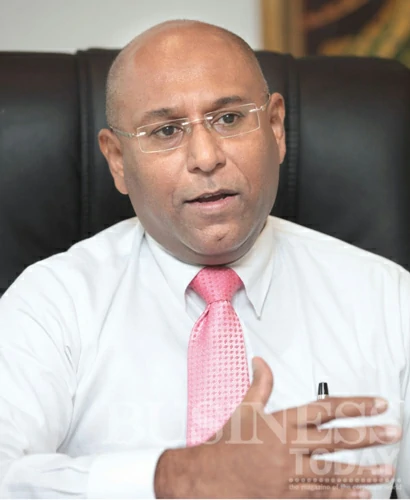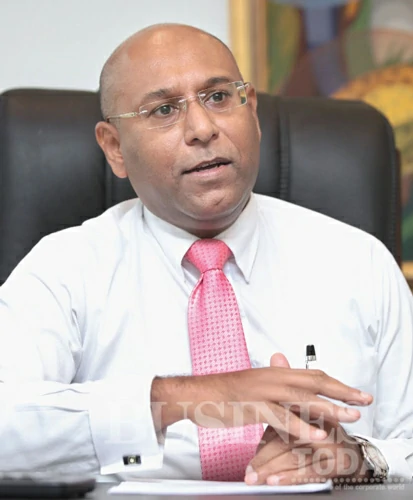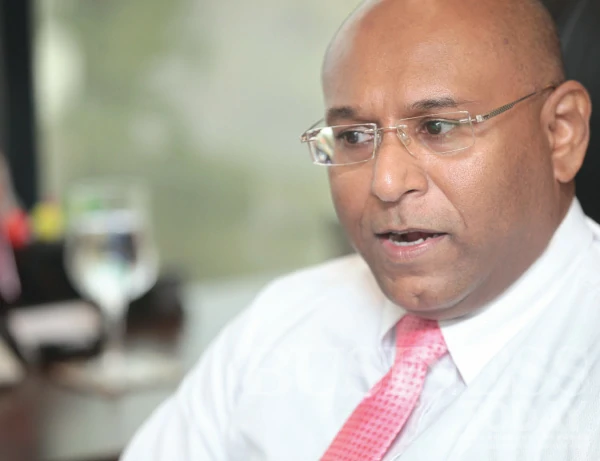
Dimantha Seneviratne, newly appointed CEO of Pan Asia Bank has begun a journey of consolidation, where the Bank will give greater focus to diversifying its asset base including growth in the SME sector. As a mid-size bank, Pan Asia Bank has the flexibility to adjust according to customer needs, an advantage they will capitalise on.
By Udeshi Amarasinghe
Photography Indika De Silva
As the recently appointed CEO of Pan Asia Bank, can you tell us about the plans that you have for the Bank?
I was appointed in March this year and I have been on the job for three months. We have many plans but the immediate priority is optimising the full potential of
Pan Asia Bank. We have 77 branches of which, nearly half have been established during the last two and
a half years. However, we have not reached the full potential from those branches. Our prime goal this year is to consolidate on this platform and reap the best from the investments we have already made and to align the thinking of the staff with the strategic goals of the Bank. We have over 1,200 staff and getting them to understand where we want to be is a priority. Having completed our Corporate Plan for 2014, we are now in the process of forming our Strategic Plan for the next three to five years. All in all, we plan to improve on the bottom line by adding value to what we offer to customers and how we offer them and in the process improve the shareholder value.
These are the immediate priorities for the Bank. During
the first two months of being CEO,
I visited most of the branches to understand how they work,
the limitations we have and the opportunities available. With that understanding and with the support from my senior management and guidance from the board of directors, we are working towards taking Pan Asia Bank to greater heights.
With more than 23 years of experience in the Banking sector can you elaborate on the experience and expertise that you bring to this role?
Of these 23 years of banking
I was with Sampath Bank for six years, that’s where I started my career soon after completing my degree. I was initially with Finance and later moved on to corporate banking. Then for two years, I was with Overseas Trust Bank, again in corporate banking, which was a branch of Hong Kong based OTB before it was converted to Nation’s Trust Bank. Later on, for two and a half years, I was in the Middle East, before returning to HSBC-Sri Lanka where I continued for 16 years.
In HSBC, I have held various positions covering corporate and retail banking, all aspects of risk management and several other areas. I was the Chief Risk Officer of HSBC-Sri Lanka and Maldives from 2007-2011 and was involved in shaping up HSBC’s retail banking repositioning through a consumer credit review. I was also seconded to HSBC Bangladesh as Chief Risk Officer and later on, my last posting was as Chief Risk Officer, HSBC Thailand. Therefore, it is a mix of overseas and local banking experience in diversified fields that I bring in to Pan Asia Bank. My experience in consumer risk management will come in handy to expand our card base and personal loan portfolio, which is relatively small where we see the opportunity to grow on a portfolio driven basis. Corporate and trade are two other areas along with risk management, which I am quite familiar with; if you look at Pan Asia Bank approximately one third of the book is corporate banking and the remaining is in retail banking, we can develop this further.
If you take Thailand, they are
a much more advanced economy
with a well developed debt-capital market. As an ASEAN country,
their implementation time lines for ICAAP and the BASEL III are bit earlier than us; hence I was exposed to these regulatory developments. Sri Lanka is also gradually moving towards these time lines.
The focus that we really want to bring into Pan Asia Bank is on SME. In the past our focus has been on retail banking with certain products that were catering only to individual borrowers. SMEs I believe present a huge growth opportunity for a mid-size bank like ours. Within the current corporate space it is difficult to compete with the margins, however there is a big untapped
SME opportunity that we can reach through our branch network, to get involved in economic growth that’s happening in other regions, which was hitherto limited to few
provinces.
SMEs usually find it difficult to approach a bank because of the procedures involved. How can we make banks more accessible to the SME sector?
The potential is there and it is how we approach the SME sector that matters. That is where we
need to improve-the skill set of branch managers and the credit officers. Similarly we have to provide education to the SME sector as well on how to develop a proposal, or to approach a bank and the documents that they need to prepare so that the bank can evaluate their credit with faster turnaround. It can be a project loan or it can even be for an SME, located in the region, which may not be aware of the various products that the bank can offer. Most SMEs are familiar only with the overdraft line as the popular mode of finance,
but there are many other custom made facilities that the bank can offer. We will be looking at educating SMEs on what is available and how they can harness the full opportunities of the banking sector.
We are working on a range of training programmes for the branch managers and also to the second level credit officers to further their knowledge so they can harness this potential sector and guide them as financial advisors.
Pan Asia Bank is a mid-size Bank, what can you tell us about the strength of the bank and will we see further expansion?
I would consider the major strength of this bank as our staff, dynamic spirit and team work ability. Furthermore, the ability to develop innovative products as well as our ability to adjust the products to customer needs in a shorter time frame is another advantage. That is where we get the support of the board of directors and the credit committee. Unlike some of the bigger players we can be flexible according to customer needs. That has been the strength of Pan Asia Bank in the past and going forward it will continue to be so. There are several innovative products that the Bank came up in the past and we will continue to develop such products to cater to the client’s requirements.
With regard to expansion, about half of the branches are quite new; therefore I consider this as a consolidation year. We have grown quite fast similar to some of the other local banks. And it made sense, to open branches in the North and East, soon after the civil conflict was over. Pan Asia Bank too expanded in these areas. This year it is about maximising the benefits of these investments that we made during the last two and a half years. There could also be a few branches coming up this year.
Our Chairman, Mr Nimal Perera Has Been Providing Us With Tremendous Guidance And I Cannot Stress Enough On The Strength, Support And Strategic Direction That He Provides To The Organisation.
We are also moving towards a new Core Banking system by the third quarter of 2014, with a significant IT investment to expand our system capabilities to provide greater service with a range of products.
Apart from this infrastructure growth, our focus would be on the assets and deposit growth. We are one of the few banks that recorded a growth in advances during the first quarter. We will continue that growth momentum this year.
Nimal Perera is the Chairman of Pan Asia Bank. Can you elaborate on his contribution to the growth of the Bank?
Our Chairman, Mr Nimal Perera has been providing us with tremendous guidance and I cannot stress enough on the strength, support and strategic direction that he provides to the organisation. Needless to say, his foresight, vast experience and business acumen are invaluable to Pan Asia Bank.
What are your thoughts on the overall banking sector in Sri Lanka? How can we make it more customer centric?
Banking, which used to be a rather static industry about two decades ago has now become one of the most dynamic sectors in the country. Entry of several banks made the sector highly competitive and more customer-centric. That change has already happened; today it is a very competitive market with margins shrinking rapidly.
We Have Seen A High Level Of Liquidity In The Market But Very Limited Credit Growth At The Moment. Therefore, Everyone Is Competing Within The Limited Credit Growth, Given The Excess Liquidity. As A Result It Is A Very Competitive Market With Shrinking Margins.
The interest rate offered to the deposit holders is reducing, and on the other hand, inflation is decreasing, as such the real interest rates that a depositor is actually receiving had a positive gain. But the quantum has come down; similarly the lending rates have also come down.
We have seen a high level of liquidity in the market but very limited credit growth at the moment. Therefore, everyone is competing within the limited credit growth, given the excess liquidity.
As a result it is a very competitive market with shrinking margins. Whoever manages their cost income ratio, credit quality and is more efficient in terms of customer service would be a winner in this game.
We also have to be agile to understand customer needs. That is where I see the advantage for a mid size bank like us where we can develop products that are customer centric, make adjustments quickly according to customer needs as well as develop new products in line with the requirement. There are many banks offering similar kind of services. Naturally the customer has a choice and can decide who they want to bank with. Apart from being customer centric a person will also look at the stability of the bank before depositing their money,
then the accessibility to their services such as internet banking and various other facilities.
Your thoughts on the consolidation of financial institutions?
I see many positives in that move, because 58 finance companies for a small market like this
are too much. The Central Bank
is going in the right direction.
With a reduced number of financial institutions there will be more effective monitoring. Too many companies have failed in the past and customers are not sure where to deposit their hard earned money when different finance companies are offering various schemes.
With A Reduced Number Of Financial Institutions There Will Be More Effective Monitoring… Consolidation Of The Financial Sector, Especially The Non Bank Financial Institutions Is Good For The Country For Us To Progress To The Next Level…
In terms of banking, again we need some bigger banks to reach the fullest potential via larger balance sheets to reap economies of scale, so cost income ratio can be managed down and such larger banks can tap the debt capital market with effective pricing. On the other hand there should be some mid size banks as well to cater to the needs of regional customers and SMEs who may not receive equal attention from the bigger banks.
Overall I believe, consolidation of financial sector, especially the non bank financial institutions is good for the country for us to progress to the next level in terms of Sri Lanka reaching out to higher per capita income level and over USD 100Bn economy. We will need a strong financial industry to support that economic growth.
There is a perception that banks
are getting richer, but this is not transferred to the customers.
Is that true?
In quantum you may see the banks making a huge profit but one has to ascertain whether these numbers are pre tax profits or post tax profit. On one hand, margins are thinning. Then if you look at the effective tax rate, it is around 42 percent. Most banks are now operating with net interest margin of around three percent. With average NPL ratio in Sri Lankan banks at around 5.5 percent, it is quite challenging to make higher returns.
Last year has seen profitability of banks thinning mainly due to pawning related losses. Banks need to cover-up the opportunity cost of those NPLs, as they are not gaining any interest income. Then, supporting the branch network, which is also at a huge cost. In our case 77 branches but some of the bigger banks have more than 200.
Therefore a large administrative
cost is involved in running a bank.
Return on equity to the shareholders is another aspect. We are moving towards BASEL III where higher capital requirements are needed going forward to cover up liquidity risks and other cyclical shocks. In that situation how can
we attract investors to invest more capital in a bank if the returns are low? We should provide a reasonable rate of return to attract capital and that is where the challenge is.
Also, we have seen that banks have increasingly been coming up with value added products that provide more value to customers.
All these value additions are also a way of transferring some of Bank’s profits to customers. For example, Pan Asia Bank introduced a high interest savings account which revolutionised the industry and most of the competitors also started offering similar products. The end result was that customers are able to get a much higher return on their deposits. Another example is Pan Asia Bank Black credit card which is offered at a much lower interest rate (minimum four percent saving) than competitive products, which is another way of sharing the Bank’s profitability with its customers.
What can we expect from Pan Asia Bank?
As a mid-sized bank, Pan Asia Bank will continue to offer dynamic value added products along with superior customer service to its customers. Our agility and dynamism will enable customers to reach their goals more effectively. We will also expand the horizons of local banking arena by being innovative in our product development strategy. We also expect to be an efficient business organisation that produces superior returns for its shareholders through our growth.
We would expect a major part of the growth coming from SME sector. Whilst retail lending will continue to be a major contributor, the corporate sector of the Bank also has more potential. Therefore we are strengthening our corporate side along with international trade to harness their full potential.
Final thoughts?
Overall Sri Lanka has great potential in terms of its economic growth to reach greater heights.
Sri Lanka Being In The SAARC Region With India As A Major Neighbour And With The FTAs We Have Entered, Has A Great Opportunity To Become A Regional Financial Hub… The Banking Sector Has A Big Role To Play And I Am Confident That With The Proper Direction We Can Achieve Those Goals And Much More.
We have now reached middle income status, now we have to work together to reach an even higher level. Having seen this happening in different parts of the world, as well as being exposed to the work ethics and people capabilities of other countries there is a lot more that we can do if we work together. With proper direction this country’s banking sector has a big role to play in that economic growth story. That is one of the reasons as to why I returned to Sri Lanka. The banking sector has immense potential and we have quality people. The productivity and the brain power of our people, especially the talent of the younger generation is tremendous and our ability to grasp concepts as well as our analytical skills are at a very high level.
With proper guidance and direction we can achieve more as an island nation. For instance, if you look at the financial hubs; Hong Kong has grown as the support centre for
a big neighbour such as China, then Singapore with Indonesia/ Malaysia and surrounding region, Dubai for the Middle Eastern region. Similarly Sri Lanka being in the SAARC region with India as a major neighbour and with FTA’s we have entered, has a great opportunity to become a regional financial hub. This was the theme of the conference that the Association of Professional Bankers (APB) held in 2011 during my presidency with APB, whether Sri Lanka is ready to become a financial hub in Asia. The banking sector has a big role to play and I am confident that with the proper direction we can achieve those
goals and much more.
The country has already begun that long overdue journey to be an economic hub in the South Asian region and all factors seem to be in place for strong economic development. This is indeed an exciting era to live in and we are very excited to be a part of this growth story of the country. We all as citizens of Sri Lanka have a duty to make use of this rare opportunity by ensuring harmony and fair play, which will ensure the required stability to our society.







